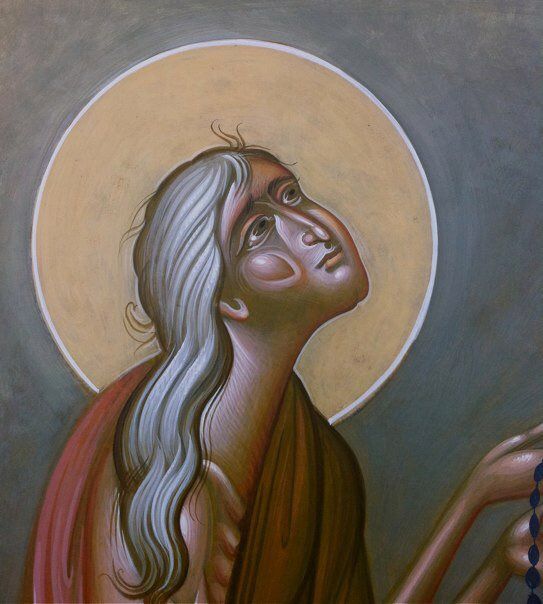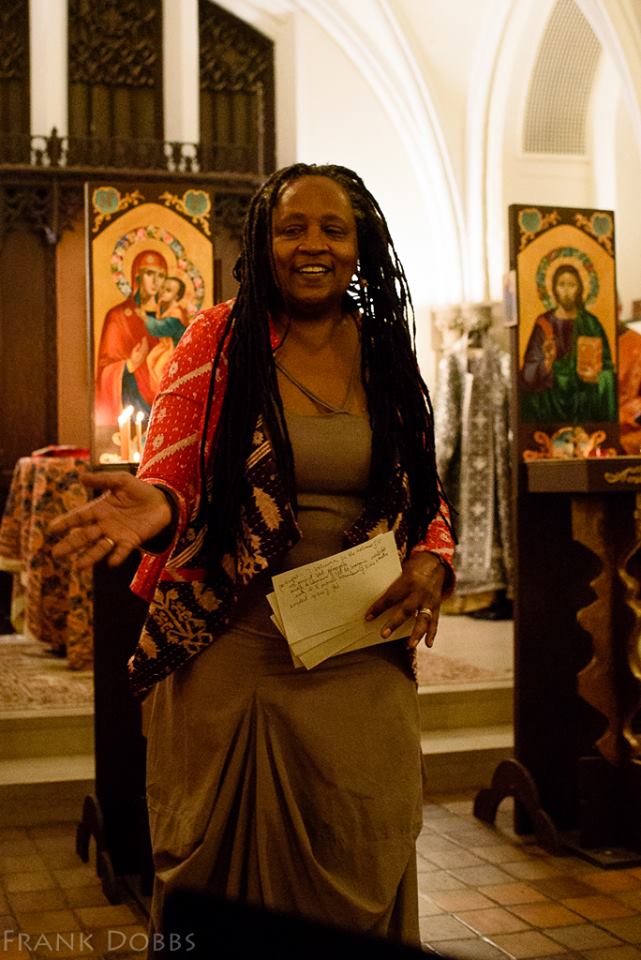
We remember St Mary of Egypt on the 5th Sunday of Great and Holy Lent every year. When she was a young woman she ran away from a prosperous home to the city of Alexandria, where she lived a life of depravity and lasciviousness. One day she saw a group of young men, pilgrims on the way to Jerusalem to celebrate the Feast of the Cross.
She followed them on the boat, paying her fare with her usual custom, but when she joined them to go to church she was stopped, blocked, by a powerful force, greater than any she had ever known. In that state of paralysis and rejection she felt a profound realization of the depth of her sin.
Paralyzed, she looked towards an icon of Mary Theotokos. And in that gaze, Mary Theotokos spoke to Mary of Egypt. Mary of Egypt, following the Virgin’s words went on to be baptized and then crossed over the river Jordan to live in the desert, where she stayed for 17 years.
The desert is a powerful space and metaphor in our tradition going back to Old Testament biblical times. Moses saw the burning bush in the desert; the people of Israel wandered there for 40 years; John the Baptizer welcomed crowds from the city exhorting them to repent as he baptized them in this same river Jordan. And Jesus himself spent 40 days in the desert alone before his final journey to the Cross. The monastic movement of early Christianity, exemplied by Anthony, led men and women into the desert to find themselves as people of God, to be spiritually awakened and to teach others.
And what is the desert? A physical, geographic space that is across the border from civilization, from society’s structure and norms and rules and relationships. It is barren, with no obvious source of food or shelter from the burning sun by day and the total darkness and brutal winds at night. There are no roads no landmarks no escape from prowling lions and beasts and predatory vultures. It is also a conceptual space in that it forces people into a new sense of self. Who are we in this endless, open, exposed and lonely space. Who is there to hear us if we cry? Who will help us? When do we get out?
Thus, in geography and spirituality the desert is a place of transformation. It is here that Moses saw the burning bush, heard the voice of God and received his mission to liberate his people. It is here that the people of Israel received the Ten Commandments, learned to live with the manna and water that God provided, received the priestly orders... in short it was here that they forged their identity as Jews. John the Forerunner prepared people for who was to come by bringing them out to this frontier space. And Jesus was tempted by the devil and overcame his destructive and seductive allures.
People are challenged in the desert. They are transformed, but they also maintain the memories and experiences of their former lives. Peter Anthony Mena* writes brilliantly and provocatively about the migrant experience from Mexico and South America, people who face danger, death, hunger and thirst to come to a promised land, with no guarantees, no warm welcome, no real idea of what their life will be and who they will become—- and compares this to the Lives of Saints Anthony, Paul, and Mary of Egypt.
Mary became a creature of the desert and she became a holy woman. In her holy state, she maintained some of the patterns and behaviors of her earlier life only now they were transformed, turned inside out, flipped on their head. When the monk Zosimas on his Lenten sojourn first sees her he is not sure if this creature is animal or human. When he discerns that this indeed a woman he calls out to her, “Why are you running from me, Holy one?”
He recognizes her saintliness. She can walk on water, she hovers over the earth, she knows Zosimas’s name and his mission, And yet her old patterns are there too. Once again she is naked--only now she is ashamed before Zosimas (who offers her his cloak). Her insatiable needs are now expressed as a fierce hunger for God. Mary’s dedication and life of privation—- for indeed she has had nothing to eat, and her body was ravaged and baked by the sun. She became a living sacrifice with a dedication to God--as the Theotokos dedicated her life to her son, who suffered and died on the Cross. And when Mary and Zosimas trusted each other she lay down with him, man and woman, covered only by his cloak.
Mary of Egypt had much experience laying with a man. But this time they lay side by side and opened their hearts to each other. She told Zosimas the story of her life, and he was in awe of her deep understanding, her compassion, how she was bold enough to face her previous life and bring that passion and energy to God, how she had struggled in the desert and continued to learn. We will never know everything that Mary told him. But he was filled with a holy fervor. He learned from her how to bring the Spirit to his community, how to encourage and support harmony and devotion, how to be a man of God in a community of believers.
What does this mean for us today? I am feeling very much as though I am living through a desert experience. It does not compare to Mary’s, or to that of the people around the world who are seeking safety and freedom by moving across deserts and seas to find themselves corralled in pens and refugee camps. But it is intensely humbling and frightening. And I thought how it would be for me to meet Mary, to pray to her just as displaced persons around the world pray. What would I say, because I know it is important for me to search my soul and try to understand all that I am feeling. It will help me put words to some of these feelings, to sort through their complexity and relieve the pressure by bringing them to a spiritual being who can understand and maybe help me find some clarity and suggest a way through.
If we don’t take the time and space to reflect, we will flounder, become alienated from our souls, our true feelings. We can retreat into our own inchoate surface calm and inner turmoil. In the words of Gabriel Garcia Marquez: “What matters in life is not what happens to you but what you remember and how you remember it.”
So I find a space, try to find quiet and solitude, light a candle in front of her icon. Here are some of the feelings and experiences I bring to her:
My home, which has been my place of solace and comfort, now feels at times like a prison, and I feel sad about that and ashamed because I do have a home and it is beautiful.
My mother died in June, and my husband’s mother died in February. We say to each other that we are glad that they did not live to see this, frail as they were, and then we feel guilt for expressing gratitude for their passing.
This will be the first Passover without my husband’s mother (who was Jewish), and his siblings and cousins all vowed that they will not let the family go their separate ways... but what will the Seder be like with everyone in their own homes.
I feel really old now, really old when I’m told not to leave the house because I’m 73. I am blocked at the door because of my age... but then again it is a blessing to be this age.
This virus exposes, once again, the great inequities of our society. The very rich have fled to their summer homes or off to Tulum, and many of my friends are stuck in small apartments with their families and children and yet still have to leave every day, ride mass transit, for jobs that pay less than minimum wage and take trains that are as crowded as they are at rush hour because service is cut and subway workers are sick and there are homeless people sleeping in every car.
My musician friends have no jobs, no hope for any gigs for the foreseeable future, and yet we have so much more time to practice—- slowly and beautifully letting the sounds fill our souls.
The playgrounds are locked and the Parks Department have dismantled the basketball hoops. Basketball, where young people trapped in their homes and in their current situation find community, practice moves of great strength and power, live out their dreams and emulate their heroes. Adults come from around the world to test their skills on the great city basketball courts. Imagine NYC without basketball but with chains and dismantled equipment instead.
A neighbor has psoriatic arthritis and continues her medical practice because “she took an oath,” she says. But her 17-yearr-old son refuses to stay home, goes out with his friends, comes home in the early morning hours. “You cannot come home,” his father has told him. “You are endangering your mother.” They text lovingly every day, but the son has returned home.
The corner boys selling heroin and cocaine are wearing masks and gloves because they don’t want to get sick, which is ironic because the conventional weapons they have secluded nearby to protect themselves from drive-by shootings are ineffective against this invisible enemy.
And my son and daughter who live near Montefiore Hospital hear the sirens all day long... and people are dying and dying and dying.
When this is over, and it will be, we experience great relieve at its end but but also great wails of grief for those buried without prayers and those who mourned without hugs.
Those are the things I have brought to Mary as I pray for her intercession this week. But then I remember that our church has a sacrament, one where we bear our souls, share our inner lives and are heard with compassion and understanding. It’s called confession. And we are blessed with a priest who is filled with devotion; who listens to us speak and hears the music behind the words... the troubles and triumphs that we may not be able to express so easily. He cannot offer the Eucharist now. And he cannot anoint us. But he can meet with each one of us, intimately, you, the priest and God as we unburden our souls. And at the end the priest prays, turns to you and says, “Pray for me.” And we know that we are both fallible human beings, mumbling and stumbling around God’s holy earth in God’s love and grace.
*Peter Anthony Mena, Place and Identity in the Lives of Antony, Paul, and Mary of Egypt: Desert as Borderland, Palgrave MacMillan, 2019.
The icon is by Fr. Jerome Sanderson.
Judith Scott holds a master's in theology from Union Theological, where she was a student of Fr. John McGuckin.



